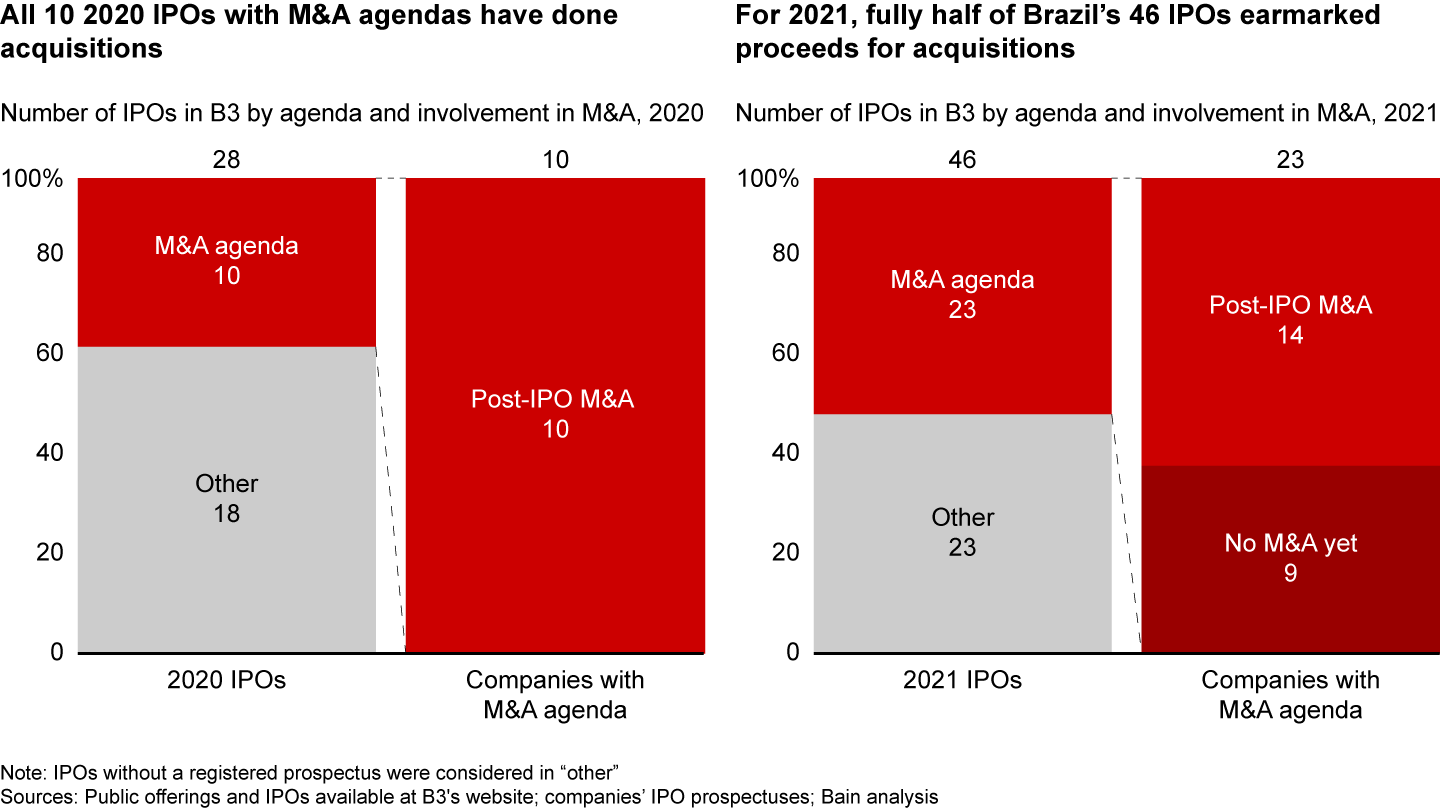M&A Report

At a Glance
- M&A activity in Brazil reached a 10-year peak in 2021.
- The majority of large deals were scale deals for consolidation across diverse industries, such as utilities, healthcare, and retail.
- While macroeconomic forces contributed to the high deal activity, two factors were specific to the Brazilian market: a record-setting number of initial public offerings generating proceeds for acquisitions and the government’s aggressive sale of its assets and state-owned businesses.
This article is part of Bain's 2022 M&A Report.
In line with global trends, Brazil’s deal activity reached a 10-year peak after a strong 2020. Transaction value totaled $66 billion in 2021, which is less than the value reached in 2010, but that was a banner year in which the concession of pre-salt to Petrobras and multiple consolidations in the telecom industry pushed the numbers sky-high. The 10-year record total deal value in 2021 even considers Brazilian real depreciation against the US dollar.
Large deals (those valued at more than 10 billion Brazilian real) accounted for about 50% of the total deal value in 2021. Most deals were scale deals aimed at consolidation, and they cover a diverse set of industries. For example, in healthcare, Hapvida Participacoes e Investimentos and Notre Dame Intermedica Participacoes merged. In utilities, Cedae concession, the Rio de Janeiro sanitation company, was acquired by Iguá and Aegea. The energy industry’s big deal was Raizen’s purchase of Biosev. In auto rental, Localiza merged with Unidas, and retail saw Carrefour acquire Grupo BIG.
Meanwhile, small deal activity got a boost from the increased number of acquisitions in the tech sector. Tech deals, which have doubled in count since 2016, currently account for around 30% of the existing number of deals, but they account for only about 5% of total deal value.
Successful, well-capitalized companies acquired less-strong competitors, many of which were weakened during the pandemic.
What’s behind these numbers? A positive macroeconomic environment propelled by low interest rates and a favorable currency for international investors is at the top of the list. Also, 2021 saw a rise in the amount of capital raised through initial public offerings (IPOs) and used for acquisitions. There was a constant push for innovation via the acquisition of new technology capabilities. And successful, well-capitalized companies acquired less-strong competitors, many of which were weakened during the pandemic. A final yet important factor was the government’s push to sell state-owned assets, such as refineries, and its sale of water, sewage, and other concessions.
While all these forces played a critical role in sustaining M&A activity, two of them are specific to the Brazilian situation and merit special attention:
- the rising number of IPOs; and
- the government agenda of selling state-owned assets.
The IPO factor
After a 12-year historic high in 2020, with nearly 43 billion Brazilian real raised in 26 IPOs, 2021 set a new record, with 64 billion Brazilian real raised in 46 IPOs. This positive scenario is also influenced by macroeconomic factors, such as high liquidity, low interest rates, and a steep increase in the number of local investors looking for higher returns in capital markets.
According to IPO prospectuses, 50% of the companies that had an IPO in 2021 planned to deploy part of the proceeds toward acquisitions, with 61% of them ultimately involved in acquisitions (see Figure 1). Yet there is evidence that more purchases may be forthcoming in 2022: All the companies that went public in 2020 and that planned to use those IPO proceeds for M&A eventually made at least one acquisition.

The government agenda factor
The year 2021 has brought an uptick in the purchasing of government-owned companies. Since 2016, the Brazilian government has pursued an ambitious program to raise private capital across several initiatives, including concessions, sales of public assets, and private-public partnership projects. This program has fueled a number of M&A deals and boosted the value of those deals. New legislation and regulations were approved to enable access to private capital, such as the new “Marco do Saneamento” legislation. Additionally, there was a shift in the overall strategy in which state-owned companies sell assets, such as Petrobras refineries.
Although the overall result of 64 billion Brazilian real is less than initial expectations, it represents the impact of the state agenda. Examples include the regional concessions in water supply and sewage (in Alagoas, Amapá, and Rio de Janeiro) representing around 30 billion Brazilian real, airport concessions totaling 3.3 billion Brazilian real, and Petrobras’ refineries sales for 9.1 billion Brazilian real. And more concessions are in the government agenda, including:
- Eletrobras (energy) privatization already was approved by Congress and could begin in the first half of 2022, with the Brazilian government diluting its majority stake by issuing new shares.
- Eight port terminals were added to the current infrastructure concessions to be auctioned in 2022, including a terminal from Porto de Santos, the largest port in Brazil.
- At least three more auctions are already planned for water supply and sewage concessions facilitated by “Marco do Saneamento.”
The year 2021 saw an uptick in the purchasing of government-owned companies.
2022 outlook
While these tailwinds could continue to propel M&A activity in Brazil, there are some potentially significant headwinds that could derail efforts. In addition to global risks, such as supply and demand shocks and pandemic uncertainties, Brazil faces a much higher rate of inflation than its international peers, which could require further intervention from the central bank. Growth estimates point to lower growth rates for 2022.
Moreover, presidential elections will be held in 2022. That could bring additional instability and make companies more cautious—to the point at which they might postpone major strategic decisions.
